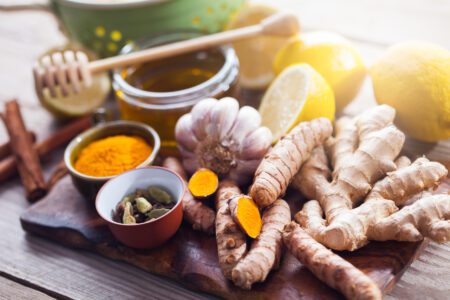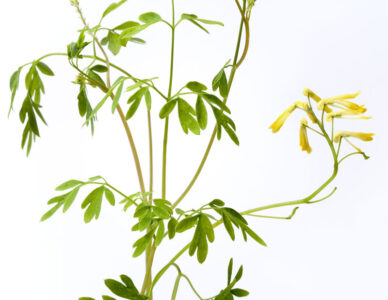The following recipes, which demonstrate some classic Indian techniques with spices, are from The Vegetarian Table: India, by Yamuna Devi (Chronicle Books, 1997).
Pumpkin and Toor Dal Bisque
Aloo Dum (New Potatoes in Cashew Broth)
Mung and Cauliflower Kitcheree
Tamil Nadu Curry Powder
Yamuna devi is a chef whose work has evolved over the years to reflect her changing values and life choices. She has merged traditional Indian vegetarian cooking with a culinary style uniquely her own that emphasizes fresh foods and intriguing herb and spice combinations. The result is a sumptuous yet healthy cuisine that is both traditional and altogether new.
In 1966, Joan Campanella met the Indian swami Srila Prabhupada in New York City, where she assisted him in preparing a wedding feast. He soon became her spiritual teacher, she his devoted disciple. She adopted Hinduism and took the Sanskrit name Yamuna Devi as a symbol of her commitment to a new way of life. In 1970, Yamuna went to India and remained there for two years. With the swami and others, she traveled the length of the country, attending holy fairs, festivals, and other spiritual events. Along the way, she slept in royal palaces, tents along the riverbeds, and many simple Indian homes.
India is a country of 600 million vegetarians and many different regional cooking styles. At each home in which the travelers dined, the swami would ask Yamuna, “Can you make this?” and then tell her, “Go learn,” whereupon she would go into the kitchen with her notebook and find out how to prepare the dish in question. This quest for knowledge became a mission, and Yamuna subsequently spent seventeen years in India studying the Vaishnava kitchen (Vaishnavism is a major Hindu sect) and regional cooking throughout India.
In 1987, Yamuna completed a cookbook, Lord Krishna’s Cuisine, which has since become a much-acclaimed classic of Indian vegetarian cooking. Returning to the United States, she settled in Key West, Florida, and began a decade-long adventure in fusing her knowledge of Indian, Caribbean, and New York spa cuisines with the abundant seasonal produce now available to her. Today, Yamuna’s cooking is contemporary, fresh, and filled with marvelous flavors and textures, but it is rooted, with respect and love, in the traditions of India. As she explains, if we always hold onto those things in our lives that don’t change, then the meals we serve may reflect the times and trends and our increasing knowledge of fine eating and good health, but they will also reflect those deeper attachments.
Flavors of the temple
The cooking style of the temple–the dishes prepared for the holy men–is the heart of India’s traditional vegetarian cuisine, according to Yamuna. The foods and spices used reflect the beliefs of Hinduism. Temple cooks use no onions and garlic, for example, in the belief that they give rise to passion.
When Yamuna told me that she had not cooked with onions or garlic herself for twenty-five years, I was shocked. What surprised me most was that I had been cooking from her cookbooks for several years and hadn’t even noticed their absence. That she nevertheless achieves such well-balanced, delicious flavors is indeed a feat.
The secret, it seems, is in the lively use of spice blends. Indian cooks use spice combinations in endless variation, including curry powders with as many as twenty different spices and the pungent garam masala made from ground spices such as cardamom, cinnamon, cloves, coriander, and pepper, as well as other masalas (the Hindu word masala means spices).
To intensify their fragrance and flavor, whole seeds are toasted until they darken or heated in a dry pan until they pop, or they may be crushed or ground in a stone mortar before heating. Fresh ginger and hot chiles are often combined with spices, mashed to a wet paste, and fried in oil.
Many of the herbs and spices used in Indian cooking (see “The Indian Kitchen” below) not only add layers of taste that play on the tongue, but serve as digestive aids. Ayur Veda, the ancient Sanskrit text that describes the traditional Hindu medical system, tells us that food is medicine, both preventive and curative.
Cooking pursuits
Yamuna’s most recent project is Yamuna’s Table, a cooking school in Sedro Woolley, Washington, that explores the relationship between the garden and the table. The school’s organic vegetable, fruit, and herb gardens are tended by staff who are passionate about both gardening and cooking. Students take part in the planting and harvesting, as well as the cooking, experiencing every aspect of food preparation. In the cooking school’s first year, the students planted seeds of more than seventy varieties of plants well suited to the cool, moist climate, and the results have been glorious.
In the kitchen, the focus is on dishes that are fresh, beautiful, and easy to prepare. In addition to fresh produce, they contain freshly ground flours, spice blends, herb purees, and homemade condiments, cheeses, and yogurt. The students also concoct light versions of foods from many ethnic cuisines, discuss the relationship of food to health, and learn to look at food as an art form.
I find Yamuna and her style of cooking both simple and complex, like a perfectly blended masala. The intense but balanced flavors of her recipes leave me feeling well fed and pleasantly surprised. Try a few yourself.
The Indian Kitchen
The following are some ingredients that Yamuna Devi considers essential for anyone who does much Indian vegetarian cooking. Some are available in supermarkets; the rest can be found in Indian groceries.
• Asafetida (hing) is a dried gum resin from the giant fennel Ferula assa-foetida. The intensity of color and flavor varies considerably according to its source, but generally the fresh resin is tan and darkens to chocolate black with age. Asafetida’s flavor has been likened to that of onions or garlic. Sulfur compounds give it a strong, overpowering smell; it is used only in small quantities. Yamuna tests her recipes with the mild, readily available asafetida sold under the name Vani.
• Chiles (har is fresh, lal mirch is dried, puissi lal mirch is cayenne) are varieties of Capsicum annuum that are used in masalas and to make food mildly hot to scorching. For flavor, Yamuna prefers the ancho, chipotle, and New Mexico chiles grown in the United States.
• Coriander (dhania) is the seed of Coriandrum sativum, which is used whole, ground, or coarsely crushed. Cilantro (har dhania) is the leaf of the same herb. Both are used widely in Indian cuisine.
• Cumin (jeera), the seed of Cuminum cyminum, is nearly always dry-roasted before being used whole or ground. Cumin plays an important role in Hindu cooking.
• Curry leaves (kadhi patta or meetha neem), from the small tree Murraya koenigii, look like small lemon leaves. The fragrant plants grow wild in Indian forests, and the leaves are used fresh in many dishes and as an ingredient of curry powder. Curry leaves, which are sold fresh in Indian groceries, can be kept in an airtight container in the refrigerator for about two weeks; they lose their intensity on drying.
• Curry powders (kedhi podi) are spice blends generally referred to as “masalas”; made of local ingredients, they differ from region to region. They are easy to prepare and far superior to store-bought versions (see the recipe here).
• Garam masala (jram masala) is an aromatic blend of several dry-roasted and ground spices that is added toward the end of cooking. Recipes vary enormously: Yamuna offers eight in Lord Krishna’s Cuisine: The Art of Indian Vegetarian Cooking. Some commercially prepared masalas are available.
• Mustard seeds (rai) include the more common brownish black or purplish brown seeds of Brassica juncea as well as the hotter, more pungent black seeds of B. nigra. When mustard seeds are heated in ghee (clarified butter) or oil, they pop, turn gray, and develop a nutty taste.
• Black peppercorns (kali mirch) are often used, and a pepper mill is an essential piece of equipment in the Indian kitchen. Yamuna prefers Tellicherry or Malabar peppercorns.
• Salt in several forms–common table salt, rock salt, sea salt (sambar namak), and Indian black salt (kala namak)–is used to season cooking grains and dals (pureed and spiced legumes).
• Turmeric (haldi), the underground rhizome of Curcuma longa, is native to South India and Southeast Asia and is generally used in ground form. Turmeric is an essential ingredient in the food of every region. Good-quality ground turmeric is readily available and keeps well, or a paste of the ground fresh rhizome can be frozen for storage.
Among the relatively few herbs whose leaves are used in Indian cookery, the native mint (podina) is sweet and pungent and is often used with ginger and lemon to flavor beverages, legumes, dairy products, rice, and vegetables. Camphor basil, or karpoor (Ocimum kilimandscharicum), is the only basil used in Hindu cooking; it flavors rice, vegetables, and dals. Holy basil (O. sanctum) is never used in cooking but is cultivated extensively for use in worship in temples and homes throughout India.
Susan Belsinger cooks and gardens in Brookeville, Maryland. She is the author of many books, most recently Basil: An Herb Lover’s Guide with Thomas DeBaggio, published by Interweave Press.













